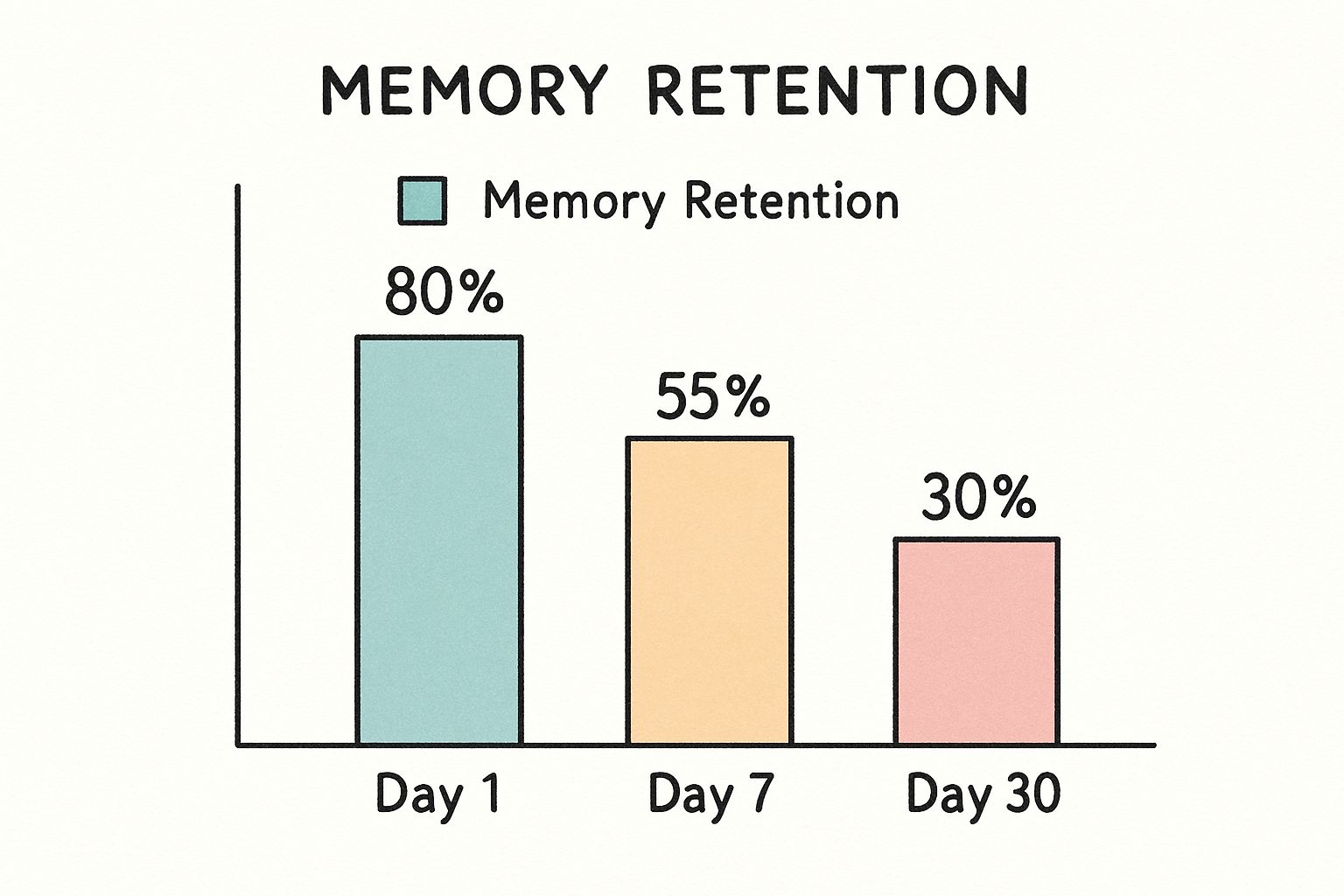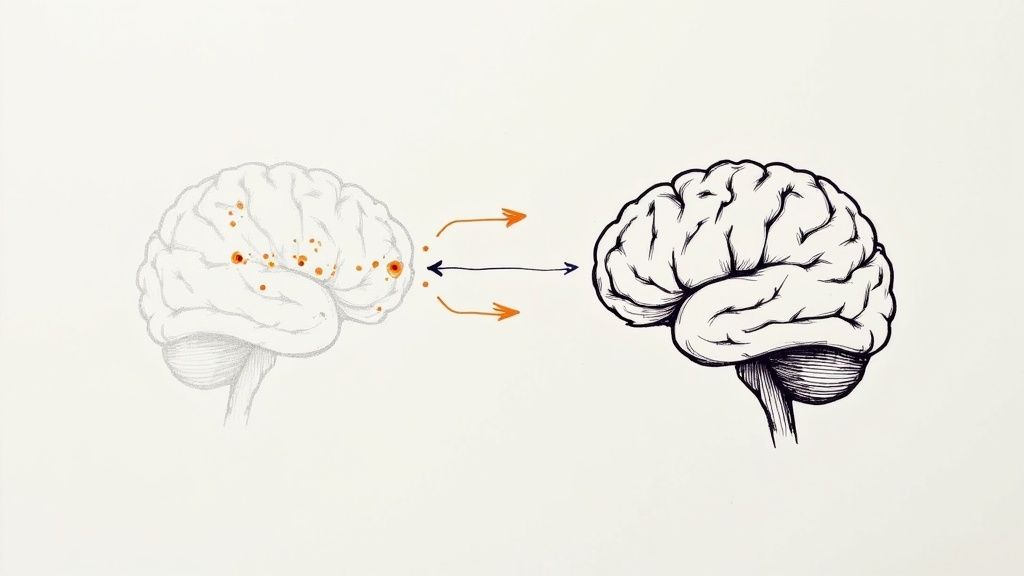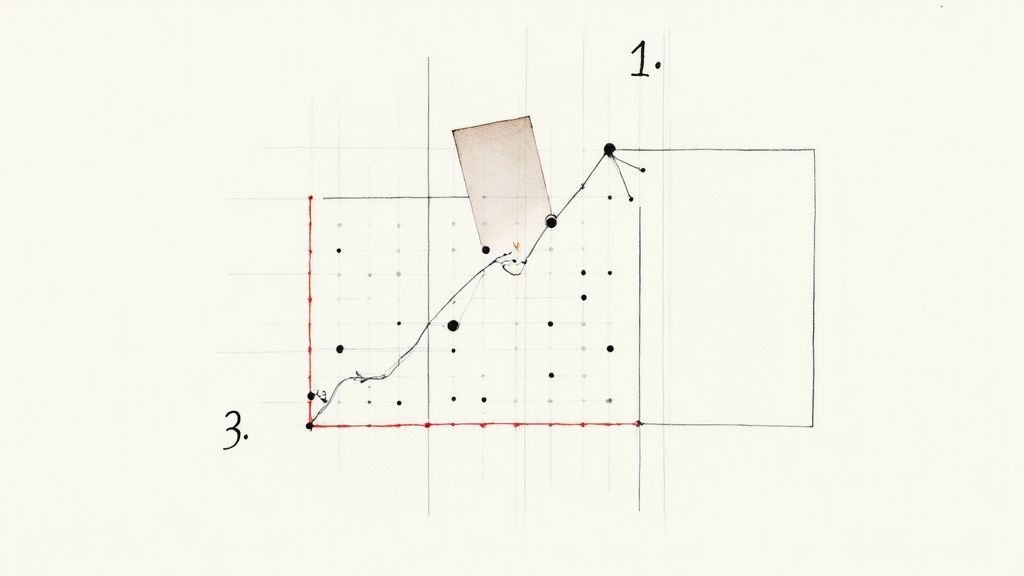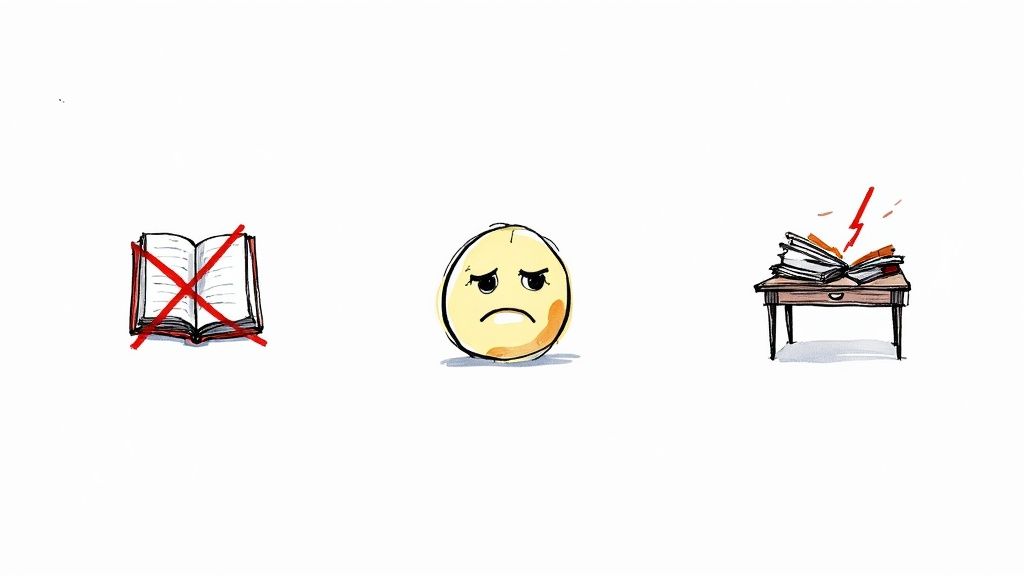Master Exams Using Spaced Repetition Study Method

The spaced repetition study method is a learning technique that feels a bit like magic, but it’s pure brain science. It’s all about reviewing information at progressively longer intervals. Instead of cramming, you revisit material at the precise moment you're about to forget it, which forces your brain to build a stronger, more permanent memory.
Why Cramming Fails and Spaced Repetition Succeeds
Let’s be honest, we’ve all been there. You pull an all-nighter before a big exam, fueled by caffeine and sheer willpower, only to find that the information vanishes a week later. That’s cramming, or “massed practice,” in a nutshell. It stuffs information into your short-term memory, which is like writing in sand—it creates the illusion of knowledge, but it doesn't last.
The spaced repetition study method is a completely different game. Think of building memory like building muscle. One marathon gym session (cramming) will leave you exhausted, not strong. But consistent, well-timed workouts build real, lasting strength. Spaced repetition does the same for your brain, turning flimsy short-term recall into solid, long-term mastery.
Working With the "Forgetting Curve," Not Against It
Our brains are actually wired to forget. It’s a survival mechanism to prevent us from being swamped by useless trivia. A 19th-century psychologist named Hermann Ebbinghaus first mapped this out with his "forgetting curve," which shows just how quickly and predictably we lose information we don't actively try to retain. Cramming is a futile fight against this natural process.
Spaced repetition, on the other hand, strategically works with the forgetting curve. Every time you review a topic just as it’s getting hazy, you reset the curve, making it flatter. This means you can wait longer and longer between reviews without losing the information. This approach is a game-changer for dense, technical subjects, like preparing for a tough certification. Many students find it indispensable when mastering the AZ-204 exam using dedicated tools like AZ-204 Fast.
The whole idea is beautifully simple: by timing your reviews to interrupt the natural forgetting process, you force your brain to work a little harder to retrieve the memory. It's this "desirable difficulty" that makes the memory stick for good.
The chart below shows just how steep that drop-off in memory can be without a smart review strategy.

As you can see, without reinforcement, memory retention can plummet to around 30% in just a month. This really drives home how inefficient learning something only once can be.
Spaced Repetition vs Traditional Cramming
To see the difference clearly, let's put the two approaches side-by-side.
| Aspect | Spaced Repetition Study Method | Traditional Cramming |
|---|---|---|
| Timing | Reviews are spaced out over increasing intervals (days, weeks, months). | All studying is packed into one or a few long sessions right before an exam. |
| Focus | Long-term retention and true understanding. | Short-term recall for immediate performance (like an exam). |
| Memory | Builds strong, long-term memory pathways. | Relies on fragile, short-term memory that fades quickly. |
| Efficiency | Highly efficient; maximizes retention with minimal time over the long run. | Inefficient; requires re-learning the same material from scratch later. |
| Outcome | Deep, durable knowledge that can be applied in the real world. | Superficial knowledge that is mostly forgotten after the test. |
The takeaway is clear: while cramming might get you through a test tomorrow, spaced repetition builds knowledge that will actually serve you in your career.
The Science of How We Remember and Forget

Have you ever wondered why some things you learn stick with you for years, while others disappear almost as soon as you close the book? It’s not random. There's a whole science behind how our brains hold onto information, and this is the foundation of the spaced repetition study method. It’s not just a study tip; it's a system grounded in the very mechanics of how we learn.
Think of your memory like a muscle. When you first learn something, like a new Azure CLI command, it's like lifting a weight for the first time. The muscle is engaged, but the gains are temporary unless you train it again. If you don't, that strength fades away pretty quickly. This natural decline is what psychologists call the Forgetting Curve.
Pioneered by Hermann Ebbinghaus way back in the 1880s, the Forgetting Curve illustrates a simple but powerful truth: we forget things at a predictable and surprisingly rapid pace. In fact, the most significant drop in memory happens within the first 24 hours. A single, intense study session is like one trip to the gym—it's a good start, but it won't build lasting strength on its own.
The Power of "Desirable Difficulty"
So, how do you build that mental muscle? This is where the real genius of spaced repetition shines. Every time you review a piece of information, you're doing another rep, strengthening that memory. But the trick is all in the timing. Reviewing too soon is a waste of effort, and if you wait too long, you've forgotten it completely and have to start over.
The sweet spot for a review is right at the moment you’re about to forget. Forcing your brain to recall something at this point takes a little effort. It's a bit of a struggle, and that struggle is what cognitive scientists call desirable difficulty.
It might sound strange, but letting yourself almost forget is precisely what cements a memory for the long haul. That slight mental strain signals to your brain, "Hey, this is important! Don't lose it." This process makes the memory far more resilient.
This is a world away from cramming. When you cram, you're just bombarding your brain with information without ever giving it a chance to forget and actively retrieve. Without that "desirable difficulty," the knowledge is fragile and fleeting.
How Each Review Builds a Stronger Memory Path
Each time you successfully recall something, you’re not just hitting refresh. You're fundamentally changing how that memory is stored. Imagine your brain is a vast, dense forest. The first time you learn something new, you're hacking a rough, narrow path to a specific spot. It's easy to get lost trying to find it again.
But every time you successfully retrieve that memory—especially when it takes a bit of work—you're widening and clearing that trail. The path becomes well-trodden and easier to follow. This is the basic idea behind what’s known as the study-phase retrieval theory.
Research consistently shows that this act of reactivating and reinforcing memory pathways makes spaced learning far more effective than studying in one big block. As you can read in this in-depth research on learning strategies, spacing out your learning sessions also helps encode information in different contexts, making your memories more flexible and easier to access when you need them.
The spaced repetition study method beautifully combines these two principles—fighting the Forgetting Curve and using study-phase retrieval. It tracks your performance to schedule your next review session at the perfect interval, strengthening your knowledge just before it fades. It's a scientific approach that ensures your hard work translates into lasting knowledge, not just a temporary brain dump.
From a German Psychologist to Modern Study Apps

The spaced repetition study method feels like a modern invention, something cooked up in our current obsession with productivity hacks. But its story actually begins over a century ago with a single psychologist and a relentless series of self-experiments. This isn’t some new trick; it’s a fundamental principle of learning, refined over decades of research.
Our journey starts in the late 1800s with Hermann Ebbinghaus, a German psychologist captivated by how we remember and, more importantly, how we forget. In the 1880s, he began a painstaking process of memorizing thousands of nonsense syllables—think "WID" and "ZOF."
His goal was to study memory in its rawest form, without the influence of pre-existing knowledge. He discovered something profound: we forget information in a predictable pattern over time. But he didn't stop there. Ebbinghaus found he could fight this natural decay by reviewing the syllables at specific, ever-increasing intervals, which dramatically improved his long-term recall.
From Theory to Validation
For a long time, Ebbinghaus's ideas were mostly confined to psychology textbooks. His "forgetting curve" was a fascinating concept, but its real-world application needed more rigorous testing to prove its worth. That crucial validation came nearly 100 years later, cementing the method's scientific credibility.
In 1978, psychologists Thomas Landauer and Robert A. Bjork gave Ebbinghaus's work the scientific backing it needed. They conducted a study with psychology students, asking them to remember face-name pairs. Their research confirmed that spreading out the review sessions didn't just work—it massively boosted recall compared to cramming the reviews close together. This foundational research is a key part of the history of spaced repetition.
This study provided the hard evidence for what Ebbinghaus had observed decades earlier. It proved the spacing effect was a real, powerful phenomenon that could be reliably used to make learning stick.
“The most effective strategy for retaining information is to review it at increasing intervals, strengthening the memory each time it’s about to fade.”
This very principle is the engine behind every modern spaced repetition system. The goal isn't to study harder; it's to study smarter by working with your brain's natural rhythm.
The Dawn of Digital Spaced Repetition
The final piece of the puzzle was bringing the spaced repetition study method out of the lab and into our hands. The biggest hurdle was managing the complex schedule. Manually tracking when to review hundreds or thousands of facts with paper flashcards is possible, but it quickly becomes an overwhelming chore.
The digital leap forward was pioneered by people like Dr. Piotr Wozniak in the late 1980s. He developed one of the very first computerized spaced repetition algorithms, which he called SuperMemo. This was a game-changer. For the first time, a computer could track a learner's performance on every single piece of information.
The algorithm was elegant. It would show you a fact, and you'd rate how well you remembered it. Based on your answer, it calculated the perfect time to show you that item again—maybe in a few days, a few weeks, or even months down the road. This brought a few huge advantages:
- Automation: The software handled all the tedious scheduling.
- Personalization: The review intervals were tailored to your unique memory patterns.
- Efficiency: Your study time was laser-focused on the exact information you were about to forget.
This innovation turned spaced repetition from an interesting psychological theory into a powerful, practical tool anyone could use. Today, this core idea is the backbone of countless learning apps, including specialized certification tools like AZ-204 Fast. The path from a psychologist's notebook to intelligent software proves a simple truth: understanding how our brains learn is the key to unlocking our true potential.
Applying Spaced Repetition to Your AZ-204 Exam
Knowing the theory behind the spaced repetition study method is one thing, but actually using it to pass a beast of an exam like the Microsoft AZ-204 is where the rubber meets the road. This exam is notoriously dense, covering a massive range of services and concepts—from Azure Storage and Cosmos DB to App Service and Azure Functions.
Let’s be honest, just reading the docs or binging video courses isn't going to cut it. With so much information to absorb, the forgetting curve will have a field day with your memory. To succeed, you need a system that methodically drills hundreds of critical facts into your long-term memory. This is exactly what a well-executed spaced repetition strategy provides.
Breaking Down the AZ-204 Beast
The first step is to take the huge AZ-204 curriculum and slice it into tiny, "atomic" pieces of information. The idea is to create simple question-and-answer pairs that you can review in seconds. A classic mistake is making your flashcards too broad.
For instance, a bad flashcard might ask: "Explain Azure Cosmos DB." A question like that is far too open-ended. It doesn’t test a specific fact and lets you get away with passive recognition. You'll glance at a long answer, think, "Yeah, I kind of know that," and move on without actually cementing anything.
A much better way is to create sharp, focused questions. Take a look at these examples:
- Question: What's the default consistency level for a new Azure Cosmos DB account?
Answer: Session consistency. - Question: Which API is best for new graph database apps in Azure Cosmos DB?
Answer: Gremlin API. - Question: Name the five consistency levels offered by Azure Cosmos DB.
Answer: Strong, Bounded Staleness, Session, Consistent Prefix, and Eventual.
See the difference? Each one targets a single, testable fact. This format is perfect for the rapid-fire reviews that are the heart of an effective spaced repetition study method. Answering these specific questions forces your brain into active retrieval, which is the secret sauce for building strong, lasting memories.
The goal is to make every review a small test of one precise piece of information. This forces your brain to work just hard enough to pull out the answer, creating the "desirable difficulty" that makes knowledge stick.
Of course, creating and managing hundreds of these cards by hand is a massive chore. You'd have to figure out a system to track which cards you've mastered and which ones you keep forgetting. This is where a good tool becomes a game-changer.
Let a Tool Handle the Heavy Lifting with AZ-204 Fast
Instead of getting bogged down in manual card creation and scheduling, a dedicated platform like AZ-204 Fast does the work for you. It comes loaded with a pre-built library of over 280 atomic flashcards, all designed from the ground up for effective spaced repetition. The system handles all the scheduling behind the scenes.
As you go through the cards, you simply rate how confident you were in your answer. The platform's algorithm takes that feedback and builds a personalized study plan tailored to you.
Here's a glimpse of the kind of personalized feedback the tool provides:
This dashboard instantly shows you which exam topics are your strong suits and which ones need more work, so you can focus your energy where it counts. The system makes sure you’re constantly strengthening your weak spots without wasting time on concepts you already know cold.
This adaptive learning is what makes the spaced repetition study method so powerful. It takes the guesswork and grunt work out of studying, letting you focus completely on learning. This targeted approach makes your study time incredibly efficient and seriously boosts your chances of success on exam day.
Best Practices for Effective Spoken Repetition

Jumping into a spaced repetition system is a brilliant first step, but how you use it is what really separates success from frustration. A few key practices can take your study sessions from a passive chore to a powerful way of building knowledge that actually sticks. These strategies will help you sidestep common mistakes and squeeze every ounce of value out of your review time.
The most important shift in thinking is understanding the difference between simply recognizing an answer and truly recalling it. Recognition is that easy, familiar feeling of seeing an answer and thinking, "Oh, right, I knew that." Active recall, however, is the mental workout of pulling that answer from your memory without any prompts. That effort is the secret sauce of an effective spaced repetition study method.
Master the Art of Active Recall
Every time a flashcard pops up, you have a choice. You can flip it over right away, or you can genuinely try to dredge up the answer on your own. Forcing yourself to do the latter is what forges strong, lasting memories.
To make sure you're always practicing active recall, stick to a few simple rules during your reviews:
- Commit to an Answer: Before you even think about revealing the answer, say it aloud or scribble it down. This holds you accountable and stops you from falling into the "I basically had it" trap.
- Be Brutally Honest: If your answer was just a little off, mark it as incorrect. The system's algorithm relies on honest feedback to schedule your next review at the perfect time.
- Embrace the Struggle: That feeling of mental strain is actually a good thing! It means your brain is actively working to strengthen the neural connection to that piece of information.
The core of this practice is simple: Treat every single review card like a mini-exam. This small shift in mindset from passive reviewing to active testing is what separates a decent study routine from a great one.
Craft High-Quality Atomic Flashcards
The quality of your flashcards is just as critical as the algorithm scheduling them. The absolute best cards are "atomic"—they test one, and only one, piece of information. This keeps your reviews quick, sharp, and incredibly effective.
Think about it this way: a bad card might ask, "Explain Azure Functions." That's way too broad. A good, atomic card asks something specific, like, "What type of trigger starts an Azure Function on a schedule?"
Here are a few tips for making great flashcards:
- One Idea Per Card: Fight the temptation to cram multiple facts onto a single card. Break down complex topics into their smallest, most fundamental parts.
- Keep It Simple: Use clear, straightforward language. Long, convoluted sentences are your enemy during a fast-paced review.
- Format as Question and Answer: This structure naturally forces you to practice active recall instead of just passively reading a fact.
For those studying for a specific certification like the AZ-204, it pays to find a resource that's already done this heavy lifting for you. You can find more study tips and strategies over on the AZ-204 Fast blog.
Find Your Rhythm with Consistency
When it comes to the spaced repetition study method, consistency will always beat intensity. Studying for 20-30 minutes every single day is monumentally more effective than cramming for three hours once a week. A daily habit keeps your review queue manageable and prevents it from turning into a mountain of overdue cards you'll dread facing.
While early spaced repetition schedules were fairly rigid (reviewing after 1 day, 7 days, 30 days, etc.), modern systems are much smarter. They adapt to you, recognizing that you'll forget some concepts faster than others. This personalized approach is what makes today's tools so powerful.
Your goal is to strike a healthy balance between learning new things and reviewing what you've already covered. A good rule of thumb is to clear out your daily reviews first. Then, use whatever time you have left to introduce new material. This ensures you're constantly reinforcing your existing knowledge—which is the entire point of this method.
Of course. Here is the rewritten section, designed to sound like it was written by an experienced human expert.
Spaced Repetition in the Real World: Your Questions Answered
Once you start using the spaced repetition study method, you’re going to have questions. That’s not just normal; it’s a sign you’re taking it seriously. Moving from the theory of how something should work to the reality of fitting it into your daily life always brings up a few practical hurdles.
Let's walk through the most common questions people ask when they start. My goal here is to give you clear, no-nonsense answers based on what actually works, so you can fine-tune your approach and get the most out of this powerful technique.
How Much Time Do I Really Need to Spend Each Day?
This is the big one, and the answer is probably a relief: consistency is far more important than intensity. There’s no magic number, but for most people, a focused session of 15 to 30 minutes a day beats a four-hour cram session on Sunday every single time.
The whole point is to build a habit that sticks, even when you’re busy. A good spaced repetition system, like the one inside AZ-204 Fast, does the heavy lifting for you by managing your review schedule. Your job isn’t to watch the clock; it’s just to clear the queue of cards the algorithm serves up. Some days that might take 10 minutes. Other days, closer to 25.
When you focus on clearing your daily queue, you let the system worry about the timing. This turns studying from a dreaded chore into a simple, manageable daily task.
What Happens If I Miss a Day? (Please Don't Say I'm Doomed)
Life happens. You’re going to miss a day eventually, and it’s not a catastrophe. Modern spaced repetition software is designed to be forgiving, so don't panic if you get off track.
When you log back in, the algorithm will simply show you the most overdue cards first. You haven't broken the system or erased all your hard-earned progress. While a daily routine is the ideal for locking in knowledge, the spaced repetition study method is resilient enough to handle a few bumps in the road.
The most important thing is to stop one missed day from turning into a missed week. Just get back to it as soon as you can. The system will adapt and help you catch up.
I like to think of it like watering a plant. Forgetting once won't kill it, but a month of neglect will. Get back on schedule, and your memory will keep growing.
Can This Really Work for Big, Conceptual Topics?
Absolutely, but it requires a bit of finesse. Spaced repetition is an obvious fit for things like vocabulary words or historical dates, but it’s just as effective for understanding complex ideas in programming, philosophy, or even engineering.
The trick is to break down big, fuzzy concepts into small, "atomic" questions. Instead of one giant card that says, "Explain RESTful APIs," you create several laser-focused ones:
- Question: In the context of REST, what does "stateless" mean?
- Question: Which HTTP verb is both idempotent and used to create or replace a resource?
- Question: What’s the main purpose of the
GETmethod in a REST API?
This forces you to grapple with the individual pieces of a complex topic. By mastering the building blocks one by one, you end up with a much deeper and more durable understanding of the whole concept. This is essential for certification exams, where you need both quick recall and a solid grasp of the underlying principles to succeed.
Help! I Have a Huge Backlog of Reviews. What Do I Do?
It’s a terrible feeling—opening your study app and seeing a mountain of overdue cards. This "review avalanche" usually happens after taking a break or after being a little too ambitious with adding new material. The key is to be strategic, not heroic.
Here's a simple game plan to dig yourself out:
- Set a Daily Time Limit: Decide on a realistic amount of time you can commit each day—say, 30 minutes—and stop when you hit it. Don't even think about clearing the whole backlog at once.
- Pause All New Material: Hit the brakes on learning anything new. For now, your only job is chipping away at the existing review pile.
- Chip Away Consistently: Just do your 30 minutes every day. It might take a few days or even a week, but you’ll see that overdue number shrink.
- Slowly Reintroduce New Cards: Once your queue feels manageable again, you can carefully start learning new material.
This methodical approach prevents burnout and reinforces what the spaced repetition study method is all about: making learning a sustainable, long-term habit.
Ready to put these ideas into practice and master your certification exam? AZ-204 Fast gives you everything you need, from pre-built atomic flashcards to adaptive practice exams, all powered by a smart spaced repetition algorithm. It’s time to stop cramming and start building knowledge that lasts.
Learn more and see how it works at https://az204fast.com.
